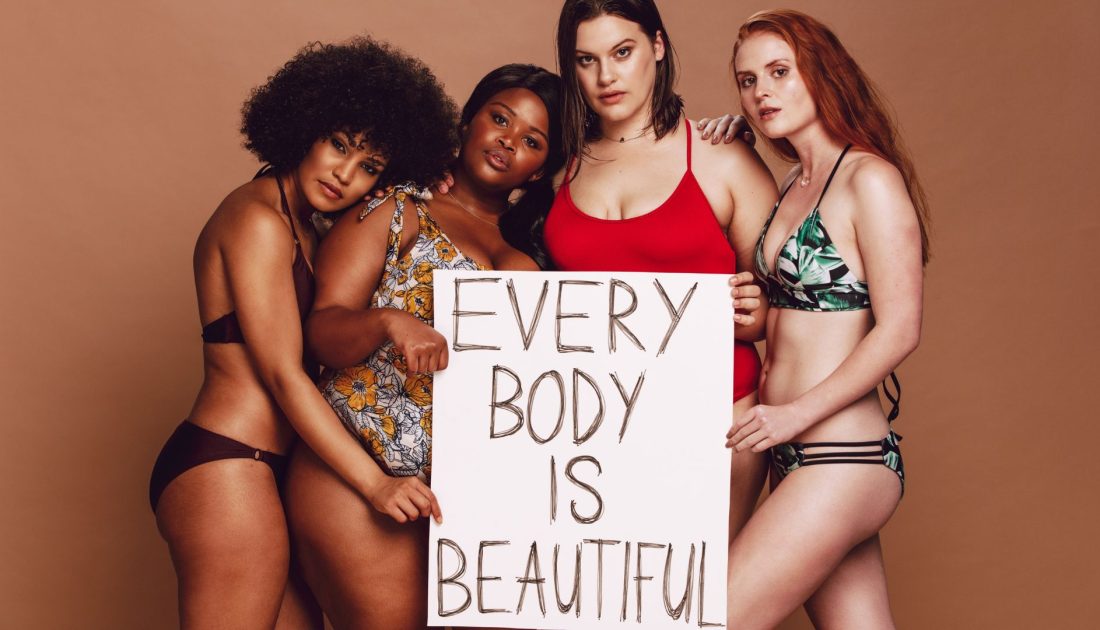THE DIGITAL CATWALK—WHERE “FLAWLESS” REIGNS SUPREME
In a world awash with Instagram selfies and TikTok transformations, the pursuit of the “ideal body” seems to be the order of the day. Whether it’s glorious glutes that defy gravity, a chiseled chest straight out of a Greek sculpture, or contoured cheeks that only look that sharp thanks to a snappy filter, the message is clear: perfection or bust. And let’s be honest, the images flooding our timelines are often less ‘real life’ and more ‘reel life’, manipulated and curated to create an illusion.
From cover models of yesteryears who set sky-high standards with their airbrushed perfection, the baton has passed to social media influencers who are armed not just with good lighting but a plethora of apps to ‘fix’ any perceived flaws. With a swipe here and a filter there, these digital avatars promote quick fixes and distort our sense of ‘normal,’ wreaking havoc on our mental health.
In this realm, the struggle with body image isn’t just a sidebar conversation; it’s the main event. And here’s where it gets even more complicated. Body Dysmorphia, a condition many still mistakenly see as a ‘female issue,’ is taking a toll on men as well. Studies are showing an uptick in the number of men turning to Performance Enhancing Drugs (PEDs) in an attempt to bulk up and measure up to these unrealistic standards.
In this comprehensive blog post, we’ll dig into the nitty-gritty of Body Dysmorphia, explore its impact on our lives, and offer some holistic approaches to regaining your self-esteem and, more importantly, your sanity.
WHAT EXACTLY IS BODY DYSMORPHIC DISORDER (BDD)?
Body Dysmorphic Disorder, commonly abbreviated as BDD, is more than just a bad hair day or the occasional cringe when you look in the mirror. It’s an all-consuming fixation on one or multiple perceived flaws in your physical appearance—flaws that are either minor or nonexistent to the average observer. According to UK stats, it’s estimated that about 1 in 50 people may be dealing with this disorder, which translates to hundreds of thousands of people across the country.
DEBILITATING SYMPTOMS: WHEN THE MIND ZOOMS IN
Now, let’s get into the really tough stuff: the symptoms that wreak havoc on someone’s daily life.
Often, individuals with BDD are entrapped in a relentless mental tug-of-war, agonizing over parts of their body they deem unacceptable. It could be any feature—skin, nose, hair, eyes, you name it. But the focus doesn’t stop there. Some don’t just fret about individual features; they’re tormented by the idea that their body parts don’t “fit together” cohesively.
Here’s the ironic bit. The coping mechanisms that those with BDD deploy usually have the opposite effect. Whether it’s piling on layers of make-up, spending an exorbitant amount of time grooming, or going to extreme lengths to camouflage their “flaws” with clothing or strategic body positioning, these behaviors aren’t about vanity. They’re desperate attempts to look “normal” or “acceptable,” but often they just serve to spiral the individual further into anxiety and self-loathing.
The disorder doesn’t just keep its claws in the mind; it reaches out to sabotage social interactions as well. Ever find it hard to make eye contact in a conversation because you’re preoccupied with how you look? Imagine that, but dialed up to a hundred. For someone with BDD, this could mean avoiding social gatherings, work, or even everyday errands.
The relationship with mirrors for someone with BDD is complicated. Some scrutinize their reflection for hours, searching for some sort of validation or hoping to “fix” themselves. Others can’t bear their own reflection and go out of their way to avoid mirrors altogether.
FROM COVER MODELS TO SOCIAL MEDIA INFLUENCERS: A CHANGE OF THE GUARD
Once upon a time, the glossy pages of magazines were the gold standard of beauty and fitness. From rock-hard abs to sultry glances, cover models set the tone for what society considered “ideal.” But let’s be real, how many of us have the time, resources, or genetic predisposition to look like a supermodel? Yet, these images were in our faces—at grocery stores, in waiting rooms, and on coffee tables.
Fast-forward to the era of Instagram and suddenly, the beauty benchmarks aren’t just limited to monthly publications. They’re on our screens every second we scroll through our feeds. Now, it’s not just the professionally photographed cover models setting the standards. It’s influencers, celebrities, and even our friends and family, armed with specific lighting, filters, and the magic of Photoshop.
Social media has democratized the act of image creation. But here’s the catch—those “perfect” images are often touched up to the point where they resemble an alternate reality. It’s not just a matter of perfect lighting; it’s a world of digital cosmetic surgery. Wrinkle gone, blemish what blemish, waist cinched, and voila! You’re social media fabulous.
We can’t discuss the shift in body image culture without mentioning the impact of celebrities, particularly the Kardashian clan. Once considered a taboo or a luxury only accessible to the Hollywood elite, plastic surgery has now entered mainstream conversation, in no small part due to celebs like Kim Kardashian and her sisters. They’ve redefined what’s “desirable” with their voluptuous curves, notably those glorious glutes, and full lips.
Not only do they openly discuss their procedures, but they also parade them on social media for their millions of followers to see. This normalization has a ripple effect. Suddenly, going under the knife doesn’t seem like an extreme measure but rather a more accessible route to self-improvement.
While there’s nothing inherently wrong with choosing to enhance one’s features, the issue arises when this becomes yet another unrealistic standard that people feel pressured to meet. For someone already battling symptoms of BDD, the idea that these ‘perfect’ physiques are attainable through surgery can become a dangerous obsession.
It’s not just women being influenced. The stigma around men getting plastic surgery is lifting, and more men are seeking procedures to achieve the chiselled chest and washboard abs promoted by male influencers and fitness gurus. Yet, these procedures, whether liposuction or muscle implants, come with their own set of risks and don’t address the underlying issues of body image or mental health.
The ‘Swipe Up to Buy’ culture on social media promotes quick fixes like never before. Whether it’s detox teas, waist trainers, or some new-fangled exercise contraption, the message is clear: you’re one purchase away from achieving that unrealistic body image.
While it’s often assumed that body image issues predominantly affect women, stats and studies are showing an increasing number of men falling prey to these unrealistic standards. The difference? Many are turning to Performance Enhancing Drugs (PEDs) in an attempt to bulk up and attain those chiselled chests and glorious glutes.
The bridge between these ever-present images and BDD is alarmingly short. When you’re continuously exposed to unrealistic standards, it can aggravate symptoms of Body Dysmorphic Disorder, making it harder for those suffering to differentiate between societal expectations and their own self-worth.
QUICK FIXES: THE PANDORA’S BOF OF THE INTERNET
The rise of the internet has given us countless blessings, but it’s also unleashed a wave of supposed “quick fixes” that promise a shortcut to a fitter, happier you. These range from “magic” diet pills and superfoods to 10-minute workout routines that claim to give you six-pack abs almost instantly.
Imagine you’re scrolling through Instagram and stumble upon a fitness influencer flaunting a perfectly toned body. They swear by a certain brand of detox tea or a “revolutionary” piece of exercise equipment. It’s tempting, right? It’s as if these influencers hold the key to an instant body transformation that you’ve been dreaming of. But let’s pause and ask: if it sounds too good to be true, might it be?
The allure of quick fixes feeds directly into the insecurities that people with BDD face daily. The notion that you can correct your perceived flaws with a simple purchase is not only misleading, but it’s also dangerous. It fosters a mentality that your self-worth is just a shopping cart away, undermining the reality that true self-improvement often involves a more complex, and personal journey.
If there’s one thing that gets overlooked in the “quick fix” culture, it’s the importance of making long-lasting lifestyle changes. It’s not just about sweating it out in the gym; it’s about creating a holistic approach that encapsulates the physical, mental, emotional, and even existential aspects of well-being. You can’t really put a price tag on that.
Imagine each good habit you incorporate is like adding a multiplier to your well-being. Eating well? That’s a multiplier. Regular physical activity? Another multiplier. Solid emotional relationships? Yet another one. Over time, these multipliers stack up, and suddenly you’re not just improving—you’re thriving.
In contrast, quick fixes are akin to adding glitter on top of mud. Sure, you might sparkle for a moment, but underneath, the issues remain unresolved. Effective change happens when you dig deep and alter your foundational habits. This is not a one-off event; it’s a lifelong commitment.
People struggling with BDD, and many others, often overlook the importance of mindfulness and the role it plays in establishing sustainable habits. Taking time to be present and understand why you’re making certain choices can be a game-changer in your health journey. It makes every step you take more meaningful and every choice more impactful.
THE SILENT SUFFERERS: MEN AND BODY DYSMORPHIA
The narrative around body dysmorphia often centers on women. The media frequently tells stories of women’s battles with body image, leaving men in the shadows. This lack of representation perpetuates the myth that men don’t suffer from body image issues, which couldn’t be further from the truth. In fact, studies are showing an alarming increase in men struggling with BDD, many turning to performance-enhancing drugs (PEDs) to bulk up.
The obsession with achieving a muscular physique pushes some men to turn to PEDs, viewing them as the quickest route to a “masculine” body. But the use of these drugs comes with a high risk, both physically and mentally. They might provide temporary satisfaction but can lead to long-term health issues like heart problems, not to mention exacerbate the emotional and psychological struggle of BDD.
The prevalence of social media isn’t helping either. We’re bombarded by images of perfectly chiseled bodies, washboard abs, and glorious pecs, which might all be enhanced by the magic of filters and Photoshop. It’s hard not to compare, and this unrealistic standard often aggravates feelings of inadequacy.
Cultural norms also play a role in silencing men. Phrases like “man up” often discourage men from talking openly about their struggles, pushing them deeper into isolation. Emotional vulnerability is not seen as a masculine trait, yet it’s a vital part of human expression and mental health.
As we know, BDD is not just a physical issue; it’s deeply connected to mental health. Men who feel like they can’t share their insecurities might not only suffer in silence but are also less likely to seek professional help. This creates a vicious cycle, making it even harder for them to break free from the grip of BDD.
But it’s not all doom and gloom. Awareness is growing, and resources aimed at men are slowly becoming more available. Support groups, counseling services, and holistic health programs that focus on men’s specific needs are emerging. It’s time to break the silence and bring men into the conversation about body image and mental health.
DIAGNOSIS DILEMMA: THE SEARCH FOR ANSWERS
One of the most harrowing aspects of BDD is the difficulty in getting a proper diagnosis. With symptoms often overlapping with conditions like depression, social anxiety, or even eating disorders, many find themselves misdiagnosed. For a condition that’s already shrouded in shame and misunderstanding, receiving the wrong diagnosis can be incredibly disheartening.
This problem is magnified in younger populations, especially teens. Being a teenager is already a complicated dance of hormones and self-discovery. Add BDD into the mix, and it becomes a recipe for extreme frustration. Adolescents often find themselves dismissed, their concerns chalked up to “just being a teenager.”
The prolonged uncertainty can push some into negative coping mechanisms like drug or alcohol abuse. It’s a way to momentarily escape, but as we both know, it only exacerbates the problem. It’s like putting a band-aid on a gaping wound—it’s not only ineffective but can also lead to further complications.
Misdiagnosis doesn’t just impact the person suffering from BDD; it has a ripple effect on family life and relationships as well. Frustration builds when loved ones try to help but can’t, often because the true problem hasn’t been identified. This can lead to tension, arguments, and in some cases, even physical aggression. It’s a tangled web that only heightens the sense of isolation for the person with BDD.
The good news is, the landscape is changing. With increasing awareness and research, more health professionals are becoming adept at diagnosing BDD. Specialized treatments that focus on cognitive behavioral therapy (CBT) and medications like SSRIs are showing promise. Getting the right diagnosis is the first step in the path towards lasting healing. It’s the gateway to tailored treatment plans that address the root of the problem, rather than just the symptoms.
FINDING YOUR WAY: SUPPORT AND HOPE
When you’re battling BDD, isolation can be your worst enemy. The importance of a support system—whether that be friends, family, or mental health professionals—can’t be overstated. Just like you wouldn’t go into a high-stakes boxing match without a cornerman, dealing with BDD is not a solo endeavor.
At the core of the support system, we have professionals trained to guide you through this journey. From psychologists to coaches like you, Julian, who focus on holistic well-being, the right support can offer not just a sympathetic ear but actionable advice.
Online forums and social media groups can also be valuable resources—yes, the very platforms that can exacerbate the problem can also be part of the solution. Finding the right community can provide the emotional support that’s so vital for managing BDD.
The role of family is often overlooked, but it’s crucial. While a family’s primary instinct might be to offer reassurance about physical appearance, what’s more helpful in the long term is emotional support and encouragement to seek professional help. Let’s be honest, all the compliments in the world won’t fix a distorted self-image, but standing by someone as they get the help they need? That’s invaluable.
Let’s loop back to the concept of habit-based coaching that P4M Coaching focuses on. Long-term change comes from internal shifts and sustainable habits, not just a quick surface-level makeover. Whether it’s adopting a balanced diet, maintaining a consistent sleep schedule, or incorporating mindfulness exercises into your day, the right habits can act as building blocks for a healthier self-image.
While BDD can feel like a never-ending tunnel of despair, it’s crucial to remember that there is a way out. Whether through medication, cognitive behavioral therapy, or lifestyle changes like the ones you instill in your clients, Julian, options are available. And each successful step taken is a ray of hope, showing that not only is improvement possible, but so is happiness.
THE WHOLE PICTURE: MORE THAN JUST AESTHETICS
We’ve navigated through the deceptive landscape of Instagram feeds and quick fixes, the surprising increase in body dysmorphia among men, and the complex challenges of finding an accurate diagnosis and effective treatment. If there’s one takeaway from all this, it’s that dealing with body image and BDD is far more intricate than just changing what you see in the mirror.
At P4M Coaching, we often field questions about why we don’t feature ‘before and after’ photos of our clients. While the progress in those pictures can be inspiring, they don’t tell the full story. Change isn’t just about going from a size 16 to a size 8 or gaining muscle mass. It’s about how you feel when you wake up in the morning, the confidence with which you walk into a room, and the joy you find in activities that once made you self-conscious.
Our focus on the six pillars of health—physical, mental, emotional, relational, environmental, and existential—is deliberate. We believe that transformation happens from the inside out. The body may be the most visible part of you, but it’s just the tip of the iceberg when it comes to overall well-being.
And there’s something empowering about that. Knowing that you’re not defined by your reflection in the mirror frees you to focus on what really matters—growing as a whole person. And let’s be real, that’s the kind of progress pictures just can’t capture.




